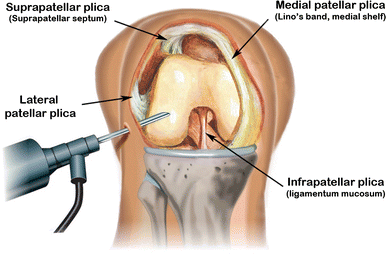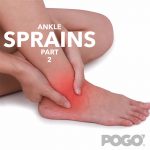Medial Plica Syndrome-What is It?
Medial Plica Syndrome
What is It?
The medial plica is an anatomical variation of the knee present in 50% of people. The knee has four different plica which are extensions of the knee joint capsule. The medial plica is a part of your knee joint capsule that extends across the inside and front aspect of the knee. It is located on the inside of the kneecap and for the most part goes unnoticed.

The four plicas of the knee.
Signs & Symptoms
In certain circumstances the medial plica can become irritated as it flicks or glides across the medial epicondyle of the knee. Signs and symptoms of medial plica pathology include:
- People will typically report pain over the medial plica with repeated knee bending/straightening.
- There may or may not also be a history of trauma
Imaging to Detect Medial Plica Syndrome
It is useful to get plain film x-rays of the knee including a weight bearing AP, lateral, and 45° patellar sunrise (axial) to exclude other pathology. Unfortunately MRI scans have also been proven to be unreliable in determining if someone has a medial plica but are very useful in ruling out other pathology. Common differential diagnosis include distal hamstring or adductor tendinopathy, pes anserine bursitis, osteoarthritis and medial meniscal pathology.
What to Do If you Suspect you Have Medial Plica Syndrome
So what if I do have a symptomatic medial plica? The first step is to trial conservative management. The focus of this is to increase the strength around the knee and pelvis, improve posture and technique, footwear and reduce the tightness of the calves, quadriceps and hamstrings. A physiotherapy approach can be ideal for addressing these focus areas. This in turn reduces the force put through the medial aspect of the knee. In one study of 136 symptomatic people, a stretching only approach the management was successful in 40% of cases, average in 20% and failed in 40%.
Some things that your physiotherapist may help you address include your pelvic stability and gluteal strength to help centre forces through the knee. Analysis of your squat/running technique to look at your knee joint kinematics and correct any poor movement patterns. Addressing any gross muscle weaknesses or tightness through the quads, calves, hamstrings or adductors with strength exercises, dry needling, massage and stretching.
What if Physiotherapy Does Not Work?
The next steps for someone who has failed to respond to conservative management is surgery. The surgeon must first rule out any kind of pathology within the knee joint such as OA or medial meniscal irritation. These can be ruled out with x-ray, MRI and arthroscope. When that has been eliminated a surgery called shelf resection is performed. This type of surgery in one trial of 68 patients had a 91% success rate but for the remaining small percentage of clients there pain was worse. This type of surgery is relatively rare nowadays since the arrival of MRI imaging.
Please leave any questions you may have regarding medial plica syndrome in the comments below.
Lindsay Young (APAM)
Physiotherapist, Author, Founder POGO Physio

References
Griffith, C. J., & LaPrade, R. F. (2008). Medial plica irritation: diagnosis and treatment. Current reviews in musculoskeletal medicine, 1(1), 53-60.
Nottage, W. M., Sprague, N. F., Auerbach, B. J., & Shahriaree, H. (1983). The medial patellar plica syndrome. The American journal of sports medicine,11(4), 211-214.
Mital, M. A., & Hayden, J. (1979). Pain in the knee in children: the medial plica shelf syndrome. The Orthopedic clinics of North America, 10(3), 713-722.
Dupont, J. Y. (1997). Synovial plicae of the knee: controversies and review.Clinics in sports medicine, 16(1), 87-122.
Johnson, D. P., Eastwood, D. M., & Witherow, P. J. (1993). Symptomatic synovial plicae of the knee. J Bone Joint Surg Am, 75(10), 1485-1496.









“This type of surgery is relatively rare nowadays since the arrival of MRI imaging.” Why does MRI imaging mean a decrease in the number of surgeries? Also, pretty scary that surgery in 9% of folks makes the pain worse :/